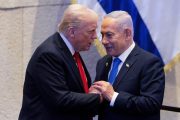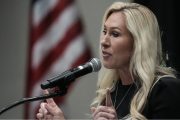“Who Will Run the World?” graces the cover of the January/February 2019 edition of Foreign Affairs, the official publication of the self-identified globalist Council on Foreign Relations (CFR). In the lead article, Foreign Affairs editor Gideon Rose gives an eye-opening survey history of the efforts by globalists to establish a “liberal order” for the world.
Rose begins his article, “The Fourth Founding,” with a brief discussion of the traditional foreign-policy view of the United States from its founding until the 20th century. He rightly admits that George Washington warned Americans about the “dangers of alliances,” and that other early American political leaders, such as John Quincy Adams, agreed with him. Adams offered the classic explanation of how America should deal with the rest of the world, saying that the United States would be the “well-wisher to the freedom and independence of all” while being the “champion and vindicator” only of its own.
But, like most globalists, Rose argues that the Washington-Adams way of dealing with other nations simply could no longer work as America moved into the 1900s. It was then that President Woodrow Wilson “first tried to found” the “international order” after World War I. Rose doesn’t say it, but Wilson called this effort at global governance a “new world order.” Rose, in his article, just calls it “the order.”
“Presidents Franklin Roosevelt and Harry Truman tried again during and after World War II,” Rose explained, calling this the second founding of the order, with the efforts of Presidents George H.W. Bush and Bill Clinton the third founding in the aftermath of the end of the Cold War.
Now, Rose is calling for a fourth founding of the order, lamenting, “In 2016, Anglosphere voters rang down the curtain on the third phase of the order’s history with Brexit and the election of U.S. President Donald Trump, and for two years, the world has drifted.”
Students of this effort to establish a global “order” have often wondered why these globalists have done certain things, and how it all fits into their push for global governance. A careful reading of Rose’s article gives us some answers. Rose writes of the First Founding of the Order, “So when the United States entered the war [World War I], it sought not only a postwar collective security system but also the removal of the Prussian autocracy.”
Why? “Wilson thought regime change was necessary because dictatorships could not be trusted to participate in his collective security system,” Rose explained. In other words, if dictatorial governments supported the formation of the new world order, they were acceptable, but if not, they must be removed from power. Over the years, the United States and other partners in the order have implemented regime change in places such as Panama, Iraq, the Philippines, Nicaragua, and China.
Alas, from Rose’s point of view, “The first attempt to found the order was in trouble by the end of 1918, was on life support by the end of 1919, and died slowly and painfully in the years after.” Rose does not mention it, but this failure was the reason for creation of the CFR and the publication he now edits — to promote the New World Order envisioned by Wilson.
But World War II presented an opportunity for a “second try” at establishing the order. “The Roosevelt administration was stocked with rueful Wilsonians. They continued to believe that the best way to protect American interests was to use American power to transform international politics.” Rather than wait until the war’s end to set this order up, Rose said a “better-designed league would be set up during the war, with American participation locked in from the start.”
Despite the best efforts of Rose’s ideological ancestors, “the American public was quickly turning inward again.” While Rose did not put it this way, patriotic Americans who valued our national sovereignty were not yet ready to turn over that sovereignty to a United Nations organization. It was obvious that supporters of the order needed to “shift course.” Instead of a “grand universal institutional framework,” a “smaller, more practical one” would be used to advance the order. This involved a more piecemeal approach, with Bretton Woods (an international monetary arrangement based on the U.S. dollar) “supplemented by the Truman Doctrine, the Marshall Plan, and NATO.”
It should be emphasized that Rose argues that these three supplements were intended mainly to promote the order’s creation. The 1947 plan to “pump American capital” into Europe (the Marshall Plan) was for the purpose of creating an “integrated European economy centered on Germany and France.”
While American policymakers did consider the Soviet Union a threat in the late 1940s, Rose said that they were not actually concerned about any threat “to the U.S. homeland.” The “threat was to the order they were trying to build.” Rose admits that “neither Congress nor the American public was clamoring for the launch of such a grand new postwar project.”
Bluntly put, Americans had — again — essentially rejected the dreams of the New World Order envisioned by the Wilsonians. It was at this point that the globalists “cleverly flipped the story, presenting its new approach not as an independent project of American order building but as a response to a growing Soviet threat.” But, as Rose readily concedes, this “distorted what was really going on.”
What was really going on was the elites using a legitimate fear of the Soviet Union’s aggressiveness to build the New World Order. As Rose explained, “Cooperative integration was sold as something that was done to bind the American alliance together to win the conflict rather than as something valuable in its own right. This went on so long that when the Cold War finally ended, many were surprised that the order continued.”
Even CFR member Jeanne Kirkpatrick, UN ambassador for President Ronald Reagan, said at the time of the Soviet Union’s collapse, “Now we an be a normal country again,” and advocated pulling back on U.S. commitments, such as NATO. But, if NATO was never about containing the Soviet menace, primarily, but rather about advancing the New World Order, that was not going to happen, and it did not happen. In fact, NATO was expanded. When President George H.W. Bush formed the alliance to push Iraq out of Kuwait in 1991, he gloated that he was establishing a New World Order, using those very words.
The end of the Cold War was not going to end the push for a New World Order — global governance — as the next president, Bill Clinton, even “advanced North American economic integration” and expanded NATO into eastern Europe! At this point, Rose fondly recalls, “the order” was stronger than ever.
But problems remained, Rose lamented, arguing that without state intervention into the economies of the world, the benefits of “capitalism” were not distributed “steadily or evenly.” Apparently, free enterprise is not a goal of the order. Another problem was that there were still large numbers of Americans who opposed the New World Order. Rose quoted one reader of Foreign Affairs: “I’ll simplify it for you: the average American rejects your Globalist, anti-American, anti-constitution, politically correct VOMIT.”
Finally, Rose turns his attention to Donald Trump, taking aim at his campaign theme of “America first,” noting that Trump wanted to take American foreign policy back to the 1930s.
Perhaps the most revealing tidbit in the Rose article was his version of an event that took place early in the Trump administration: “At one point, Trump’s entire national security apparatus gathered in the basement of the Pentagon to explain the order to him. The president was bored and implacable.”
This explains the intense hatred that the architects of the order have for Trump. American conservative constitutionalists certainly have problems with Trump, but it is clear that those who would terminate America’s national sovereignty, submerging us into their vision of a New World Order, have even more problems with him.
Rose concludes his article by looking forward to the day when “Trump leaves office” and the next president can repair “the damage” to the order.
On the contrary, we can hope that the next president can finish the job that Trump has begun, and the American people can send the order to the ash heap of history.





